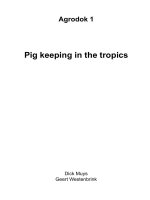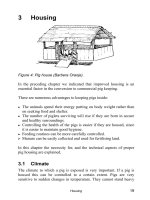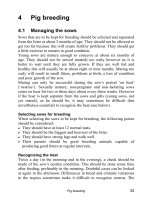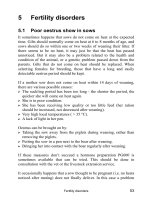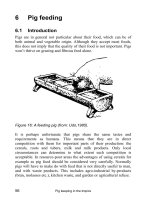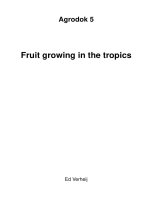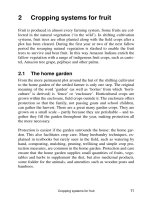Pig keeping in the tropics - part 2 pot
Bạn đang xem bản rút gọn của tài liệu. Xem và tải ngay bản đầy đủ của tài liệu tại đây (228.69 KB, 14 trang )
Housing 19
3 Housing
Figure 4: Pig house (Barbera Oranje).
In the preceding chapter we indicated that improved housing is an
essential factor in the conversion to commercial pig keeping.
There are numerous advantages to keeping pigs inside:
? The animals spend their energy putting on body weight rather than
on seeking food and shelter.
? The number of piglets surviving will rise if they are born in secure
and healthy surroundings.
? Controlling the health of the pigs is easier if they are housed, since
it is easier to maintain good hygiene.
? Feeding routines can be more carefully controlled.
? Manure can be easily collected and used for fertilising land.
In this chapter the necessity for, and the technical aspects of proper
pig housing are explained.
3.1 Climate
The climate to which a pig is exposed is very important. If a pig is
housed this can be controlled to a certain extent. Pigs are very
sensitive to sudden changes in temperature. They cannot stand heavy
Pig keeping in the tropics 20
rain or drought. Strong sunlight is bad for them, as it causes their skin
to dry out. Albino pigs especially cannot endure the sun because they
have no pigment in the skin and they soon burn. This illustrates the
necessity for shade. Pigs kept for optimal production should therefore
be protected from climatic stress. This is only possible by ensuring
that the animals are well housed.
The most important factor to consider in organising proper housing is
temperature. A pig’s body temperature can vary with the temperature
of its surroundings and a steady body temperature is important for a
proper growth rate.
Figure 5: Protection against climatic influences.
Body temperature
Every living animal produces heat, when converting its food for the
requirements of growth. The more an animal eats, the faster it
grows and the more heat it produces. Heat is also released when an
animal is active (for example, when walking).
Warm-blooded animals (birds and mammals) can make use of some of
this heat to keep their body temperature level. The normal internal
body temperature of a pig is about 38.5°C. A healthy animal will
automatically try to maintain this temperature. Any great deviation
from this norm may lead to the animal’s death, because all of its body
processes are geared to work at this temperature.
Housing 21
A sick animal’s temperature may rise to above 40°C if its temperature-
regulating mechanism is disturbed. If a pig’s temperature rises above
41°C it will die. The same applies if the temperature drops too much.
Especially in the tropics animals generally produce more heat than
they need to maintain their body at an ideal temperature. To avoid
overheating they have to get rid of any superfluous heat in one way or
the other.
Controlling body temperature
One way of dissipating heat is to give off moisture by evaporation -
‘sweating’ is an example of this process. Pigs however do not have
sweat glands and are therefore unable to do this.
Releasing heat by evaporating water from the skin is also possible if
there are puddles and pools that the animals can lie and roll in.
Moisture evaporates from the wet skin, releasing excess heat from the
body. If the water is cooler than the body the body heat will be
transmitted to the cooler surroundings. It cannot do any harm,
therefore, to provide the animals with a pool of water, as long as the
water is clean and not a health hazard. Pools are very important for
improved breeds kept enclosed but are less important for indigenous
(local) breeds. Good ventilation is also essential.
Evaporation can also take place through the mouth, and in very hot
weather pigs can often be seen panting. This is because, by breathing
more quickly, more air is exhaled through the mouth and other air
channels, and in this way more water is evaporated.
If the animal is unable to get rid of excess heat in one way or another
it will try to reduce its body temperature by producing less heat, that is
to say, by eating less and therefore not growing so quickly. If it feels
cold it will try to prevent further cooling by generating more heat, for
example by exercising its muscles (shivering). This will use up its
energy and its growth rate will fall.
Pig keeping in the tropics 22
The hide of an animal protects it from the outside world. One of its
protective functions is to help regulate temperature changes, for it
serves as an insulating layer between the internal organs and the
outside. A cow has a very hairy coat, which is one of the ways it
protects itself against the cold. A pig does not have much of an
insulating layer of hair (or fur), but it can form a layer of fat
underneath its skin.
Young piglets do not yet have such a layer to protect them, so in the
first few days after birth temperature-regulating mechanisms do not
function well. It is therefore important to ensure that the surroundings
are sufficiently warm for the piglets. As the piglets get older they will
need less heat.
Ideal temperatures for pigs
The temperature at which optimum growth and food conversion is
achieved differs with the weight of the pig:
? piglets one day old 35°C
? piglets up to one week old 30°C
? piglets up to about 8 weeks old 20°C - 28°C
? animals up to 90 kg in weight 18°C - 22°C (or a little cooler)
3.2 Technical requirements for good housing
The construction of pig pens and houses will depend to a certain
extent upon the climate and local circumstances (e.g. numbers of pigs
to be kept). Local conditions are also important, in terms, for example,
of the construction site (waterlogged, exposed to wind etc.) or the
building materials and the skills available for the construction of the
installations.
In hot, humid, or damp areas, breeze and shade are important factors.
The buildings should be as open and airy as possible. The walls of the
pens should be so constructed that the wind can pass freely through
for good ventilation. In some areas animals should be protected
Housing 23
against periodic temperature drops by ensuring that any heat can be
retained.
A few important requisites for the pen are:
? It should not be draughty.
? Bright sunshine and heavy rain should not be able to enter.
? There should be no great variation in temperature inside the pens.
? They should be easy to clean.
? Provision should be made for storing the manure, litter and run-off
for later use.
A pen satisfying these requirements will make a major contribution to
the good health of the herd, counting towards lower piglet mortality,
faster growth and increased feeding efficiency. The most suitable
housing for less intensive holdings in tropical regions consists of a
walled and roofed pen with a yard or run (see Figure 6). Bedding
material should be provided in the covered pen and the run should
contain a trough and if possible sufficient space for a large water tank.
Figure 6: Pen adapted to a tropical climate.
When building a pen, care must be taken in choosing the site. In hot
areas the site would benefit from the shade of a group of trees, as trees
Pig keeping in the tropics 24
absorb and screen a good deal of heat. The pen should be near a water
supply, so that water is readily available for the animals, and it must
be easily cleaned.
The roof
The first essential is a roof, which can be made of various materials.
The most practical approach is to use the same material as is used for
the local roofing. A roof of leaves is a good insulator against heat and
cold, but it has the disadvantage of rotting quickly. Corrugated iron or
aluminium sheets covered with leaves would last longer but are more
expensive. Other materials can be used, provided that they protect
against rain and sun, heat and cold. If possible the roof should be
constructed with its longest slope against the prevailing wind and rain.
If an opening has been left between the walls and the roof (see
Paragraph 3.5) there should be sufficient outside overhang to prevent
the rain entering.
The floors and bedding
The floor of the pen should be slightly raised above its surroundings to
avoid puddling or flooding in wet weather. It is also advisable to slope
the floor slightly, so that the pen is situated at a higher level than the
run. This will allow the liquid manure to run off more easily. If a drain
is fixed at the lowest part of the run the run-off and manure can be
collected into a pit. Pig manure is a good fertiliser so it is important to
collect it (see Paragraph 3.6).
The floor can be of compacted soil or loam; it should be kept hard and
smooth so that it can be easily swept clean. The pigs can be ringed to
stop them rooting in the soil. In Europe special pig rings (small pieces
of iron) are sold, which are pinched into the upper part of the nose
(snout) with a special tool. Wooden floors are not advisable because
the crevices make them difficult to keep clean, and the pigs bite into
them. Wood will rot when damp.
If cement is available a concrete floor is a possibility. The concrete
should not be so rough that the animals can scratch themselves on it. A
Housing 25
floor that is too smooth is also dangerous, as the animals may slip and
do themselves serious injury. To improve a floor that is either too
rough or too smooth a few shovels of soil can be thrown into the pen
every day after cleaning. This is not only a precaution against
accidents, but it is also healthy, as the animals can take up valuable
minerals from the soil (iron for example).
The disadvantage with concrete is that it is a bad insulator. In hot
weather the animals can take advantage of this by lying on the cold
concrete to cool themselves down, but in cold weather too much body
heat will be lost and the younger animals will get too cold. In young
animals this increases the risk of diseases like pneumonia for example.
The coldness of the concrete can be reduced by seeing that the animals
have bedding material in the pen. For young piglets put a cloth on the
floor. For older pigs various materials can be used, such as rice straw,
sawdust, dry leaves etc. As a precaution it is better not to use plants or
seeds that may be poisonous. Pigs have a habit of finely chewing their
bedding litter and will swallow part of it. This will not do any harm as
long as the animal does not eat harmful plants. The leaves of the
Wonder Oil Plant (Ricinus communis) for example should not be
used. Its seeds are poisonous and could get amongst the leaves.
Bedding material should be changed regularly to keep the pen clean
and to avoid any parasite build-up. The mixture of bedding with dung
and urine makes an excellent fertiliser for the fields, and is especially
valuable if specially stored for transformation into compost.
The walls
The construction of the walls depends again on the climate. In the
tropics they should be left as open as possible for good ventilation. A
low wall approximately 1 metre in height will suffice, with an opening
between the wall and the roof. In windy areas, the roof (or ceiling)
should not be too high, otherwise the pen will cool down too quickly
in the strong winds. Completely open walls, made of wire netting for
example, are seldom recommended, as pigs always like to shelter from
wind and rain. In higher and colder areas the walls should be
constructed in such a way that it is possible to close the walls of the
Pig keeping in the tropics 26
pen completely. In the daytime, when temperatures are higher, the top
section of the walls can be opened, to be closed again towards evening
to keep the warmth in. It should be possible completely to close the
side exposed to the rain.
If the walls are made using traditional mud and wood techniques a
protective row of hard wooden poles should line the inside. This will
prevent the pig from digging into the earthen wall.
The walls can also be made of boards or bamboo poles. A row of
small tree trunks will provide a simple wall, even if the wind can enter
more or less freely, as long as part of it is closed with woodwork to
allow a space for the animal to shelter.
Cement walls will be the most expensive but they are stronger and last
longer. If the supply of cement is limited, it should be used in priority
for the floor.
3.3 Feeding and water troughs
Feeding should be done outside if possible. The feed trough can be
made of cement, iron, or hardwood. The trough should be long enough
for all the animals in the pen to feed from it at the same time.
Figure 7: Separate feeding for pigs (from: Udo, 1985).
Housing 27
Animals of different sizes, older and young sows for instance, should
not be kept in the same enclosure. It may happen that weaker animals
are bitten and do not get enough to eat when feeding. The stronger
animals will fatten at the expense of the others.
If for one reason or another animals of different age and size have to
be kept together, precautions should be taken to ensure that they do
not get in each other’s way when feeding. This is possible by giving
each animal or group of animals a separate feeding space, by
enclosing them inside railed-off sections (see Figure 7). These sections
will have to be closed from behind and can be of metal or wood
(although wood wears out more quickly).
In very hot areas a water bath should be provided in the run for the
animals to cool down in (see Figure 8). The bath should not be too
deep: for older sows about 20 cm deep, for younger animals the water
level can be adjusted accordingly. Care should be taken to prevent the
young piglets from drowning.
Figure 8: Water bath in a run (after Eusebio, 1987).
The bath should be cleaned out regularly to prevent the development
of parasites and diseases. Cement is the most suitable construction
material, since a pit dug in the soil will quickly develop into an un-
manageable mud bath.
Pig keeping in the tropics 28
3.4 Sizes of pens and runs
In Figures 9A and 9B an enclosure is shown suitable for all types of
pig. If there is a run, the animals will get into the habit of going
outside to excrete. This can be encouraged by ensuring that the
covered pen is not too big. Provided that the doorway is wide enough,
the inside area of the pen need not be very large.
Figure 9: Pen and run for all types of pigs (A:side view; B:tot view)
A pen measuring 2 x 2.5 metres is adequate for a sow with a litter of
piglets. If there is no run however, the sow and piglets will need an
area of about 3 x 3 metres. The run should be 3 x 5 metres in size. It
Housing 29
should be larger if a water bath is installed and it must be well fenced,
to make sure that the piglets do not escape. These dimensions are also
suitable for housing 12 - 15 weaned piglets, or 10 fattening pigs, or 3
breeding pigs.
The pen in Figures 9A and 9B is suitable for all types of pig. It is a
good idea to put the piglets in a separate corner where they can feed
on their own away from the sow (see next Paragraph).
3.5 Housing the sow and her piglets
As we have stated, young animals should be protected from cold
directly after birth. Plentiful quantities of good dry bedding should be
available to keep the piglets warm. If this does not suffice and you
have the means, a heating lamp should be installed in a separate corner
of the pen for the first few weeks.
The piglets should, if possible, be given a secure place of their own in
the sow’s pen, but at a small distance from her. This is because there is
always the risk that the sow accidentally kills her piglets by lying
heavily on them. To make it impossible for the sow to crush her
piglets against the walls, inside the pen a horizontal rail should be
installed parallel to each wall, 15 to 20 cm away from the walls and at
a height of 15 to 20 cm from the floor.
Farrowing crate
Another solution to prevent piglets being crushed during and after
birth is to use a farrowing crate, a sort of cage confining the sow and
limiting her movement. The crate takes up a floor area of about 65 x
220 cm, and resembles a cage made of iron or wooden bars. There are
doors at the front and back of the crate. Bars across the top prevent the
sow from climbing out. The crate is installed in the pen and just next
to it a warm spot is provided for the piglets, who thus remain in close
contact with the mother but can move freely about and away from her
as they please.
Pig keeping in the tropics 30
The dimensions of the farrowing crate depend on the average size of
the sows. For smaller types the crate should measure about 50 x 150
cm, and for the larger commercial breeds 65 x 220 cm.
Piglet boxes
Figure 10 illustrates a ‘piglet-box’. This is a farrowing crate combined
with a special ‘creep’ area where the piglets are kept warm. The box
allows the piglets to crawl away from the sow to a bedded area on
either side of her. After a few days the extra shutters can be removed,
so that the piglets can run freely about the pen. This system has
proved very successful; the piglets nearly always prefer the protective
‘creep’ rather than lying against the sow. The sow should be kept in
the farrowing crate for about two weeks after farrowing.
Figure 10: Farrowing crate with covered ‘creep’ area for piglets
(from: Udo, 1985).
Housing 31
Before using the crate for the next sow it should be thoroughly
cleaned. When the sow leaves the crate a warm place should be found
for the piglets. This could be in a separate corner of the pen, where
they can be introduced to a little feed. When the piglets reach a weight
of 8 - 12 kg they can be weaned, that is to say, separated from the sow.
3.6 Housing fattening pigs
Pens to be used for fattening pigs are less demanding. There should be
no more than 10 fattening pigs in one pen, and a simple pen with a run
will suffice (Figure 9). This also applies to the breeding animals and
boars.
The breeding sows and boar can be allowed out on a fenced piece of
land occasionally, as this is very good for their general condition.
Their leg muscles will benefit and in rooting around they will find
some of the essential elements that are sometimes lacking in the feed.
This is more important for the breeding herd than for the fatteners; a
fattener will never get old (slaughter) but a good breeding pig will be
used for as long as possible.
The danger of parasite infection must be taken into account however
when putting the animals out (see paragraph 7.4).
3.7 Using liquid manure and dung
Pig urine and dung are good fertiliser for the land, so it is wise to
make good use of them. Before using the dung it is best to let it
decompose first by heaping it separately. Pigs enjoy chewing their
litter and playing with it, so it is good to give them plenty of any kind
of organic matter for this purpose. If they feel happy, their condition is
better anyway, and the manure will be better too! Once the litter from
the pens has been broken down by the pigs it should be left to rot for a
while (in the shade), by being kept moist and turned occasionally, to
approach compost quality.
Pig keeping can be combined with on-farm fish culture:- apart from
being put on the land, the pig manure can be used to fertilise the
Pig keeping in the tropics 32
fishpond. The manure, or some of the rich run-off from the pens (not
too much), will stimulate the growth of natural fishfood and water
plants. This increases the food available for the fish who in turn grow
faster. In addition, water plants such as Ipomoea reptans growing on
the surface of the water grow more rapidly and provide excellent
green fodder for pigs.
For further information on this combination see Agrodok No. 21, ‘On-
farm fish culture’.


